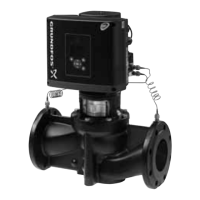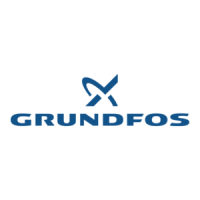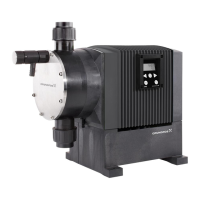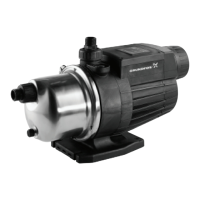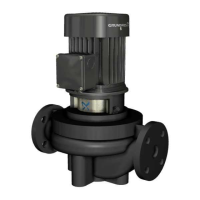Do you have a question about the Grundfos TPE 2 Series and is the answer not in the manual?
| Enclosure Class | IP55 |
|---|---|
| Frequency | 50/60 Hz |
| Protection Class | IP55 |
| Pump Type | Centrifugal |
| Pressure Rating | 10 bar |
| Material | Stainless Steel |
| Operating Pressure | 10 bar |
| Control Mode | Variable Speed |
| Communication | Modbus |
| Impeller Type | Closed Impeller |
Details on the pump's radio module for remote control and compatibility.
Information about the Li-ion battery in advanced functional modules.
How the pump is delivered from the factory.
Safe lifting and handling procedures for the pump.
Lists suitable liquids and precautions for pumping specific fluids.
Guidelines for connecting the pump to the piping system.
Instructions for rotating the terminal box for optimal access.
Procedures for correctly mounting the pump head onto the housing.
Information on mounting the pump using a base plate.
Recommendations for insulating the pump unit correctly.
Advice on preventing damage from freezing.
Requirements for adequate ventilation and clearance for the motor.
Considerations for installing pumps in outdoor environments.
Details on connecting the pump to single-phase and three-phase power supplies.
Requirements for earth leakage circuit breakers and fault protection.
Overview of terminal connections for functional modules.
Detailed terminal layout for the FM 200 standard module.
Connecting screened 3-core cables for bus communication.
Connecting screened 2-core cables for motor replacement.
Steps to clean and flush the pipe system before pump startup.
How to fill and vent the pump and system for correct operation.
Limits on pump start/stop cycles per hour.
Procedures for alternating duty and backup pumps.
Allowed liquid temperature ranges and effects on components.
Temperature limits for pump operation and storage.
Specifications for pump operating and test pressures.
Importance of correct inlet pressure for optimal pump performance.
Reference to technical data sections for motors.
Information on the pump's sound pressure level.
Conditions of the operating environment for the pump.
Overview of available control panel types.
Methods for controlling the pump remotely.
Default settings applied to pumps before shipment.
How to adjust the pump's desired setpoint using the control panel.
Example of setpoint adjustment in DP mode with sensor feedback.
Overview of the main display screen and its information.
Guide for initial pump setup and configuration.
Categorization of main menu items for the advanced control panel.
Setting the desired operational point for the pump.
Selecting how the pump operates: Normal, Stop, Min, Max, Manual.
Choosing the regulation strategy: AUTO ADAPT, FLOW ADAPT, etc.
Setting the current date and time for logging and scheduling.
Function to limit the maximum flow rate to a set value.
Energy-saving mode that reduces performance during low demand periods.
Adjusting pump performance based on liquid temperature.
Enabling or disabling the control panel buttons for security.
Configuring PI controller parameters like gain and integral time.
Defining the pump's speed range between fixed and user-set limits.
Setting acceleration and deceleration times for motor speed changes.
Assigning a unique number to the pump for identification.
Enabling or disabling wireless communication features.
Configuring the first analog input for sensors or external setpoints.
Configuring the second analog input for sensors or external setpoints.
Configuring the third analog input for sensors or external setpoints.
Setting the function of integrated sensors (pressure, temperature).
Configuring inputs for Pt100/1000 temperature sensors.
Configuring the functions of digital inputs (start/stop, fault reset).
Configuring digital inputs/outputs for various signals.
Activating specific setpoints using combinations of digital inputs.
Configuring analog output signals for monitoring pump data.
Using external signals to influence the pump's setpoint.
Configuring the first signal relay output for status indication.
Configuring the second signal relay output for status indication.
Defining actions when a monitored parameter exceeds a limit.
Defining actions when a monitored parameter exceeds a second limit.
Function to prevent condensation in motors, especially in humid environments.
Tracking motor bearing usage for predictive maintenance alerts.
Saving current pump settings for later use.
Loading previously saved pump settings.
Reverting recent configuration changes made via Grundfos GO.
Assigning a custom name to the pump for easier identification.
Setting a code to secure product access and remote control.
Selecting between SI and US measurement units.
Locking or unlocking control panel buttons for security.
Clearing logged historical data such as work logs and energy data.
Customizing the main display screen with selected parameters.
Adjusting screen brightness and auto-off timers.
Guided process for setting up pump control modes and parameters.
Providing guidance and solutions for pump failures.
Configuring the pump for operation in a multi-pump system.
Establishing communication between Grundfos GO and the pump.
How to connect wirelessly using radio frequency.
How to connect using infrared communication.
Overview of the pump's main status and operational data.
Detailed system and pump status information.
Function to calculate and monitor heat energy consumption within a system.
How to set the desired operational value for the pump.
Different modes for pump operation: Normal, Stop, Min, Max, Manual.
Setting the pump's speed directly when in Manual operating mode.
Automatic adaptation of pump performance to system characteristics.
Combines AUTO ADAPT with a maximum flow limit (FLOW LIMIT).
Guided process for setting up pump control modes and parameters.
Providing guidance and solutions for pump failures.
Routine maintenance tasks for the pump and motor.
Guidelines for returning the pump for service and information on shaft/coupling.
Voltage and frequency requirements for single-phase motors.
Specifications for earth leakage current.
Voltage and frequency requirements for three-phase motors.
Specifications for earth leakage current.
Specific installation instructions and approvals for North America.
Compliance with US and Canadian electrical codes.
FCC and IC compliance statements for radio communication.
FCC and IC identification numbers for radio modules.
Electrical connection requirements and safety for North American installations.

